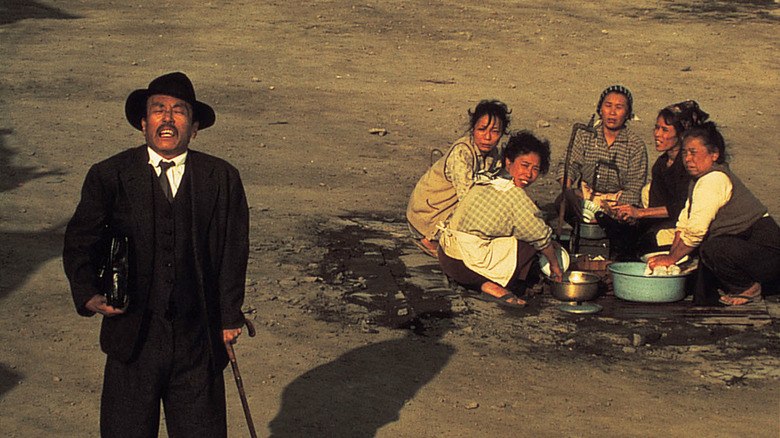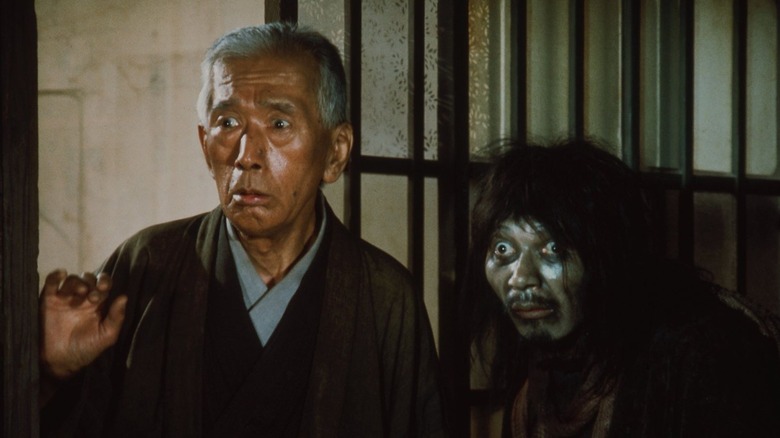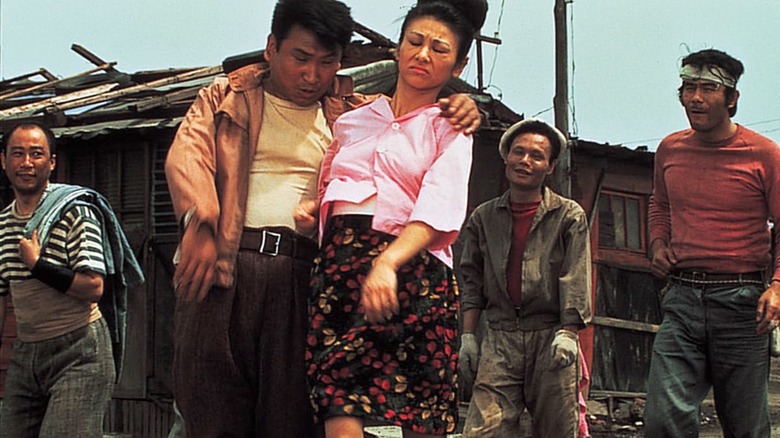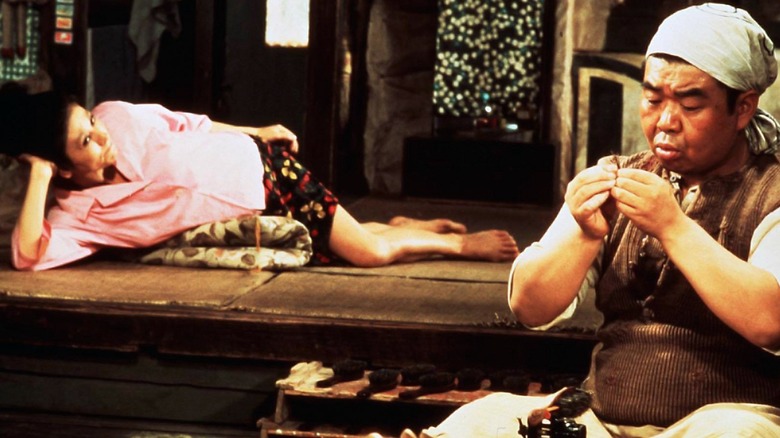Why Akira Kurosawa Waited So Long To Start Making Films In Color
"Dodes'ka-den" (1970) was Akira Kurosawa's 24th film as a director was unique in the master's filmography for many reasons. "Dodes'ka-den," made after a five-year hiatus after "Red Beard" (1965), was shot in a mere 28 days on a small budget, rumored to serve as proof to younger filmmakers that such a task could be completed. "Dodes'ka-den" was also cast with mostly unknown actors. Also unique to Kurosawa, "Dodes'ka-den" was a critical and commercial failure in Japan (despite being nominated for an Academy Award in the United States) leading to a long, deep depression in Kurosawa that, as he had admitted, led to a suicide attempt.
Eventually, Kurosawa climbed out of his depression, largely thanks to the production of 1975's "Dersu Uzala," his follow-up film. In recent years, "Dodes'ka-den" has been reassessed and come to be admired to the point of being included in the venerable Criterion Collection.
"Dodes'ka-den" is also, perhaps surprisingly, Kuroawa's first film in color. Shot by Takao Saito, "Dodes'ka-den" employed a good deal of natural brown hues and earthy colors, lending a new kind of visual texture to the film that Kurosawa has never reached before. Saito first collaborated with Kurosawa on "Sanjuro" in 1962, and would go on to shoot "High and Low" and "Red Beard" before moving into Kurosawa's color period with films like "Kagemusha," and "Ran."
Why did they wait so long to shoot in color? By 1970, most feature films were. In James Goodwin's 1994 book "Perspectives on Kurosawa," the master revealed that he had to be pushed toward color by a fellow filmmaker who forced him to watch an old Sergei Eisenstein movie.
Ivan the Terrible
It's not just that Kurosawa had trouble adapting to color, it's just that — aesthetically speaking — he preferred black and white photography. Kurosawa seems to have mastered a certain kind of shimmering, silvery photography in his modern-day films, and a textured, deep-grey natural look for his period pieces. Kurosawa is a master of visual clarity, framing, and drawing the eye to the exact correct part of the frame. With color, it seems, Kurosawa wouldn't be able to do what he wanted. He said as much relating an old conversation he once had with Henri Langlois.
"Many, many years ago (I can't remember exactly when), the then-head of the Cinémathèque Française, Henri Langlois, took me aside and told me that I had to make films in color. He showed me Eisenstein's 'Ivan the Terrible' and said, 'Look, Eisenstein was doing this many years ago and getting very good results. You must try.' But I felt at the time that the technology of color film wasn't good enough for what I wanted to do, and that's why I kept making black-and-white films."
"Ivan the Terrible" was a curious choice for an example of great color photography as Eisenstein reserved only a few color scenes for the tail of "Part II," with the rest filmed in black and white. The color scenes are certainly striking — the dominant colors of faded bloodstain red and tarnished gold are dazzling — but why Langlois wouldn't choose a film like, say, "The Red Shoes" is a little unusual. But "Ivan the Terrible" it was. Looking at "Dodes'ka-den," one can kind of see it. Kurosawa's color palate is somehow glowing and faded at the same time.
Color as setting
"Dodes'ka-den" is set in a shanty town and tells its story in multiple vignettes, each following a new set of characters. It's a study in modern poverty. In order to communicate the setting, Kurosawa decided to use color as a storytelling tool. Despite his use of unknown actors and the attempt to make "Dodes'ka-den" as grounded as possible, Kurosawa still wanted a note of artistry involved, a note of aesthetic experimentation.
"... I was inspired by what Langlois said — and I did want to try — so I made 'Dodes'ka-den' as a kind of color experiment ... It was my first color film and I tried all kinds of things — even painting the ground, not to mention the sets. To deal with these characters in their very restricted setting, I had to use color as much as possible to bring out this setting. I was consciously being very experimental here."
This wasn't an exaggeration. Kurosawa painted the ground the shade of brown he wanted. Indeed, according to Daisaku Kimura, the first assistant cameraman on "Dodes'ka-den," painting was a big part of production. Kurosawa, it seems, didn't quite trust the fineries of different film stocks to give him the visuals he wanted. If he could paint the ground the color he wanted, he was going to take that route first. Says Kimura:
"I thought he would be demanding about getting the colors he wanted, but he said nothing about that. On 'Dodes'ka-den,' what he did was to use color without relying on the film stock itself. He painted every object to be filmed. He didn't trust the film stock. He painted everything."
If the film has a strange "artificial" color look, that would be why.
The painted sky
This sort of bold artificiality might also be matched by, say, the bizarro ultra-unnatural landscapes of Federico Fellini. In Fellini's 1983 film, "And the Ship Sails On," rather than shoot on an actual beach, the director recreated a beach on a soundstage, using complicated practical techniques to make a glimmering ocean against a sun-soaked sky. For a particular sunset, Kurosawa dared not film the actual sun, but had his crew paint the sunset himself. Kimura recalls feeling a little intimidated by Kurosawa asking him to paint everything. He knew that Kurosawa was a painter and hoped his technique wouldn't be criticized.
"The sunset in the film was created on a soundstage. He told us to paint it however we liked, so I joined in. But when Kurosawa tells you to paint, it makes you nervous. He was an artist himself, so everyone was nervous. But he said not to worry, to be like kids painting picture books, so we went ahead."
Kurosawa's color experiments were not welcomed at the time and the film bombed pretty hard. This, after Kurosawa had to mortgage his house to pay for it (a story related in Michael S. Barrett's 2017 book "Foreign Language Films and the Oscar: The Nominees and Winners, 1948 – 2017). The failure of "Dodes'ka-den" was, as described, devastating for Kurosawa, and it took him a long while to get back on his feet.
In the 1980s, Kurosawa made "Ran" and "Kagemusha," some of the best Shakespeare (and Shakespeare-like) movies ever made, and which are possessed of some of the most striking color in cinema history.



